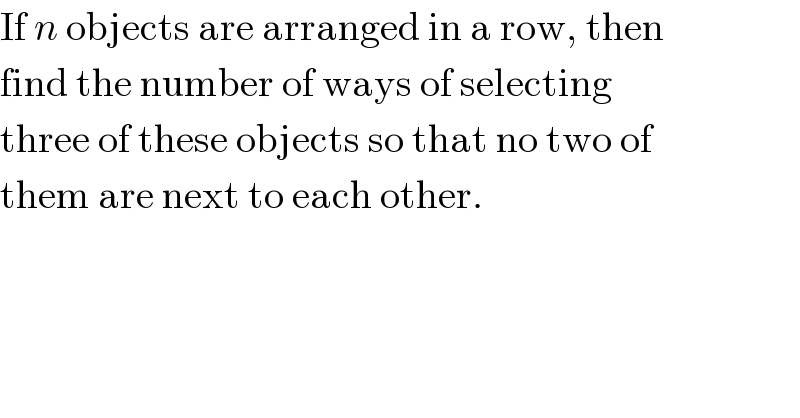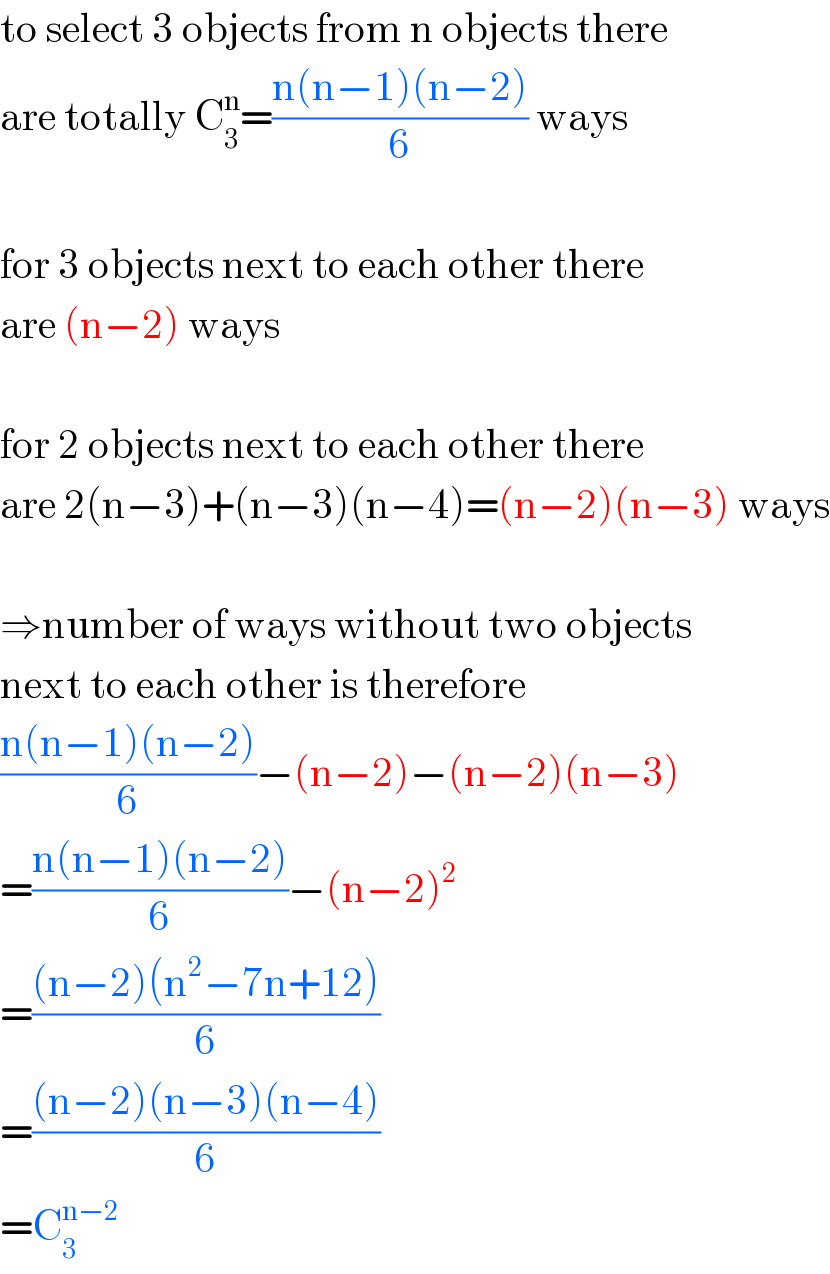
Previous in Permutation and Combination Next in Permutation and Combination
Question Number 21587 by Tinkutara last updated on 28/Sep/17

$$\mathrm{If}\:{n}\:\mathrm{objects}\:\mathrm{are}\:\mathrm{arranged}\:\mathrm{in}\:\mathrm{a}\:\mathrm{row},\:\mathrm{then} \\ $$$$\mathrm{find}\:\mathrm{the}\:\mathrm{number}\:\mathrm{of}\:\mathrm{ways}\:\mathrm{of}\:\mathrm{selecting} \\ $$$$\mathrm{three}\:\mathrm{of}\:\mathrm{these}\:\mathrm{objects}\:\mathrm{so}\:\mathrm{that}\:\mathrm{no}\:\mathrm{two}\:\mathrm{of} \\ $$$$\mathrm{them}\:\mathrm{are}\:\mathrm{next}\:\mathrm{to}\:\mathrm{each}\:\mathrm{other}. \\ $$
Commented by mrW1 last updated on 29/Sep/17

$$\mathrm{Now}\:\mathrm{I}\:\mathrm{understand}\:\mathrm{the}\:\mathrm{question}. \\ $$
Answered by mrW1 last updated on 06/Oct/17

$$\mathrm{to}\:\mathrm{select}\:\mathrm{3}\:\mathrm{objects}\:\mathrm{from}\:\mathrm{n}\:\mathrm{objects}\:\mathrm{there} \\ $$$$\mathrm{are}\:\mathrm{totally}\:\mathrm{C}_{\mathrm{3}} ^{\mathrm{n}} =\frac{\mathrm{n}\left(\mathrm{n}−\mathrm{1}\right)\left(\mathrm{n}−\mathrm{2}\right)}{\mathrm{6}}\:\mathrm{ways} \\ $$$$ \\ $$$$\mathrm{for}\:\mathrm{3}\:\mathrm{objects}\:\mathrm{next}\:\mathrm{to}\:\mathrm{each}\:\mathrm{other}\:\mathrm{there} \\ $$$$\mathrm{are}\:\left(\mathrm{n}−\mathrm{2}\right)\:\mathrm{ways} \\ $$$$ \\ $$$$\mathrm{for}\:\mathrm{2}\:\mathrm{objects}\:\mathrm{next}\:\mathrm{to}\:\mathrm{each}\:\mathrm{other}\:\mathrm{there} \\ $$$$\mathrm{are}\:\mathrm{2}\left(\mathrm{n}−\mathrm{3}\right)+\left(\mathrm{n}−\mathrm{3}\right)\left(\mathrm{n}−\mathrm{4}\right)=\left(\mathrm{n}−\mathrm{2}\right)\left(\mathrm{n}−\mathrm{3}\right)\:\mathrm{ways} \\ $$$$ \\ $$$$\Rightarrow\mathrm{number}\:\mathrm{of}\:\mathrm{ways}\:\mathrm{without}\:\mathrm{two}\:\mathrm{objects} \\ $$$$\mathrm{next}\:\mathrm{to}\:\mathrm{each}\:\mathrm{other}\:\mathrm{is}\:\mathrm{therefore} \\ $$$$\frac{\mathrm{n}\left(\mathrm{n}−\mathrm{1}\right)\left(\mathrm{n}−\mathrm{2}\right)}{\mathrm{6}}−\left(\mathrm{n}−\mathrm{2}\right)−\left(\mathrm{n}−\mathrm{2}\right)\left(\mathrm{n}−\mathrm{3}\right) \\ $$$$=\frac{\mathrm{n}\left(\mathrm{n}−\mathrm{1}\right)\left(\mathrm{n}−\mathrm{2}\right)}{\mathrm{6}}−\left(\mathrm{n}−\mathrm{2}\right)^{\mathrm{2}} \\ $$$$=\frac{\left(\mathrm{n}−\mathrm{2}\right)\left(\mathrm{n}^{\mathrm{2}} −\mathrm{7n}+\mathrm{12}\right)}{\mathrm{6}} \\ $$$$=\frac{\left(\mathrm{n}−\mathrm{2}\right)\left(\mathrm{n}−\mathrm{3}\right)\left(\mathrm{n}−\mathrm{4}\right)}{\mathrm{6}} \\ $$$$=\mathrm{C}_{\mathrm{3}} ^{\mathrm{n}−\mathrm{2}} \\ $$
Commented by Tinkutara last updated on 06/Oct/17

$$\mathrm{Thank}\:\mathrm{you}\:\mathrm{very}\:\mathrm{much}\:\mathrm{Sir}! \\ $$
